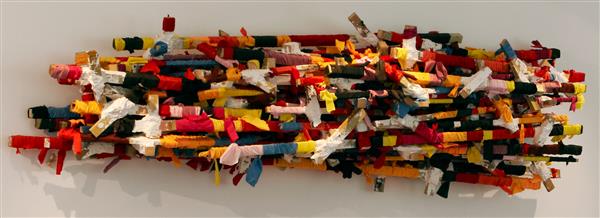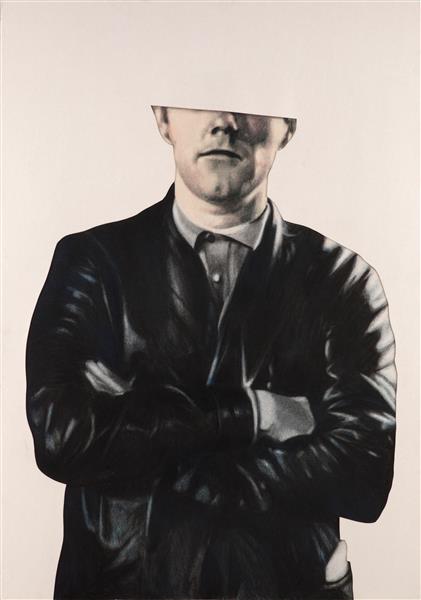STREET. Untitled: broken shelf
Phyllida Barlow
Pieces of lumber, plaster, gaze and fabric
85 × 300 × 75 cm
2010
Acquisition 2011
Inv. No. 0210
STREET. untitled: broken shelf arrived in a heap of an endless number of single parts. Rough timber lengths, with colorful shreds wound around them, held together by bright white plaster lumps. Wet material turning into a connecting element while drying. It was quite breathtaking how the artist assembled an exuberant three-dimensional painting from this chaotic pile of squared timber pieces.
When Hans Ulrich Obrist enthused about the English sculptor Phyllida Barlow, the other members of the EVN Art Council were not yet aware of the fact that large parts of the artist’s processual work have only survived in the form of documentary photographs. It was a veritable, a fabulous and fascinating discovery. Phyllida Barlow had taught at the London Slade School of Fine Arts for forty years, with such superstars as Rachel Whiteread or Douglas Gordon among her students, before the international art scene had begun to take note of her experimental work that combines passion and emphasis, resolution and courage with a fascination for material, color, and volume.
The material for Barlow’s sculptures comes from DIY stores: wooden palettes, cement, felt, plastic foam, planking panels, cables, Styrofoam, and adhesive tapes. The things are spread, piled up, amassed, broken, cut, layered, and covered with paint. Barlow’s subject is the city. She brings replicas of the unloved, overlooked, ugly urban bulky garbage into art’s white cubes, where she unfolds scenarios of crowd barriers, balconies, fences, and signs, of sewage pipes, flagpoles, and shelf systems.
Barlow’s deconstructions and her demystification of traditional sculptures, against which she deploys all the trash there is, spring from a clear-cut political attitude. Rubbish piles, homeless people’s shelters, demonstrators’ banners, surveillance instruments, barricades – all objects refer to actions, have a history: the street as an archetype of life.
Phyllida Barlow has never been interested in museum-like forms of preservation. She prefers to recycle her works in a continuing process of production and destruction. An endless chain of objects and elements from which the objects have been built waits to be used again in new spaces and contexts.
Phyllida Barlow once said about her sculptures that it would be best to see them when it is dark: we can only feel them when they have been swallowed up by night.
Brigitte Huck, 2011 (translation: Wolfgang Astelbauer)
Continue readingExhibitions
Paper, Rock, Scissors – Materials and Tools of Art , KinderKunstLabor für zeitgenössische Kunst, St. Pölten, 2025
Publications
Lower Austria Contemporary 2012, St. Pölten 2012, p. 33
evn collection. 2006–2011, Cologne 2011, p. 226–228
Phyllida Barlow - Street, , p. 10


